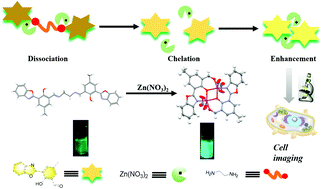A fluorogenic probe based on chelation–hydrolysis-enhancement mechanism for visualizing Zn2+ in Parkinson's disease models†
Abstract
Developing efficient methods for the real-time detection of Zn2+ levels in biological systems is highly relevant to improving our understanding of the role of Zn2+ in the progression of Parkinson's disease (PD). In this work, a novel Schiff base based Zn2+ fluorescent probe (ZP) was designed, synthesized and systematically investigated. A significant turn-on effect on ZP upon the addition of Zn2+ was observed, accompanied by a blue-shift of the fluorescence spectra. ZP is sensitive to Zn2+ and has excellent selectivity against various biologically relevant cations, anions and amino acids. The sensing mechanism of ZP was studied by 1H NMR, MS, single crystal X-ray diffraction and theoretical calculations. The results showed that the response of ZP to Zn2+ was based on the chelation–hydrolysis-enhancement process. Upon bonding, Zn2+ hydrolyzes the Schiff base to an aldehyde precursor, the resulting aldehyde further coordinates to Zn2+ to form a more stable heterobimetallic complex leading to the emission enhancement and blue-shift. ZP was applied to imaging exogenous/endogenous Zn2+ in live HeLa cells. Furthermore, we successfully measured the Zn2+ levels using in vitro PD models, which provided a visualization method to better understand the relationship between Zn2+ levels and PD development.

- This article is part of the themed collection: 2019 Journal of Materials Chemistry B HOT Papers


 Please wait while we load your content...
Please wait while we load your content...